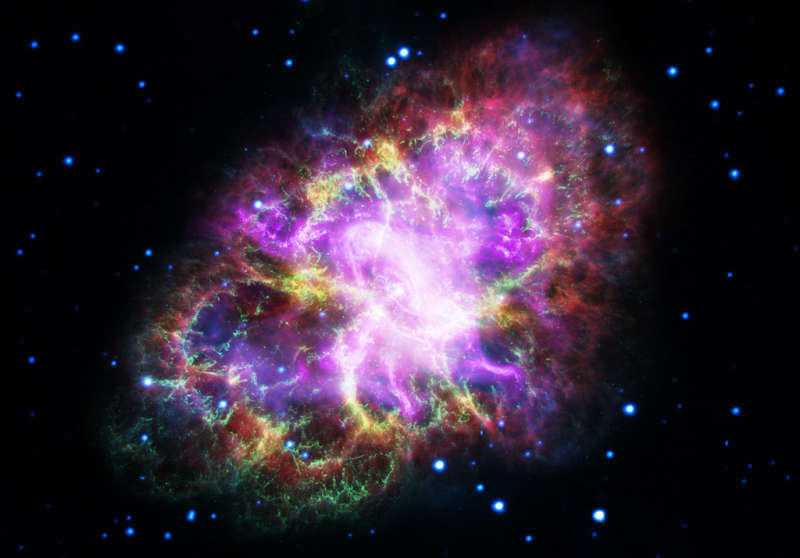
|
Credit & Copyright:
NASA, ESA, G. Dubner (IAFE, CONICET-University of Buenos Aires) et al.;
A. Loll et al.; T. Temim et al.; F. Seward et al.; VLA/NRAO/AUI/NSF; Chandra/CXC;
Spitzer/JPL-Caltech; XMM-Newton/ESA; Hubble/STScI
Explanation:
The Crab Nebula is cataloged as M1, the first object on
Charles
Messier's famous list of things which are not comets.
In fact, the
Crab
is now known to be a
supernova
remnant, expanding debris from massive star's death explosion,
witnessed on planet Earth in 1054 AD.
This
brave new image offers a 21st century
view of the Crab Nebula by presenting image data from across the
electromagnetic
spectrum as wavelengths of visible light.
From space,
Chandra (X-ray)
XMM-Newton (ultraviolet),
Hubble (visible), and
Spitzer (infrared),
data are in purple, blue, green, and yellow hues.
From the ground,
Very Large Array
radio wavelength data is shown in red.
One of the most exotic objects known to modern astronomers,
the Crab Pulsar,
a neutron star spinning 30 times a second,
is the bright spot near picture center.
Like a cosmic dynamo,
this collapsed remnant of the stellar core
powers the Crab's emission across the electromagnetic spectrum.
Spanning about 12 light-years, the Crab Nebula is
6,500 light-years away in the constellation
Taurus.
NASA, ESA, G. Dubner (IAFE, CONICET-University of Buenos Aires) et al.;
A. Loll et al.; T. Temim et al.; F. Seward et al.; VLA/NRAO/AUI/NSF; Chandra/CXC;
Spitzer/JPL-Caltech; XMM-Newton/ESA; Hubble/STScI
|
January February March April May June July August September October November December |
| ||||||||||||||||||||||||||||||||||||||||||||||||
NASA Web Site Statements, Warnings, and Disclaimers
NASA Official: Jay Norris. Specific rights apply.
A service of: LHEA at NASA / GSFC
& Michigan Tech. U.
Based on Astronomy Picture
Of the Day
Publications with keywords: M 1 - Crab Nebula
Publications with words: M 1 - Crab Nebula
See also:
- APOD: 2025 August 24 Á The Spinning Pulsar of the Crab Nebula
- M1: The Incredible Expanding Crab
- APOD: 2024 July 23 Á The Crab Nebula from Visible to X Ray
- M1: The Crab Nebula
- APOD: 2023 March 20 Á M1: The Expanding Crab Nebula
- APOD: 2023 January 15 Á M1: The Crab Nebula from Hubble
- The Spinning Pulsar of the Crab Nebula
